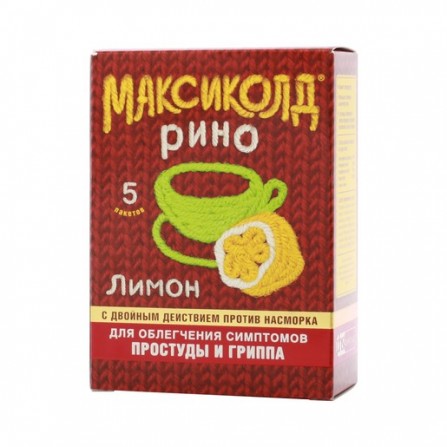Maxicold Reno powder for preparation of oral solution with lemon flavor 5 pcs
Condition: New product
1000 Items
Rating:
Be the first to write a review!

More info
Active ingredients
Paracetamol + Phenylephrine + Pheniramine + Ascorbic Acid
Release form
Powder
Composition
Paracetamol 750 mg, ascorbic acid 60 mg, phenylephrine hydrochloride 10 mg. Auxiliary substances: colloidal silicon dioxide, sodium saccharin, citric acid, sodium citrate, potato starch, quinoline yellow dye, flavoring, lactose.
Pharmacological effect
Combined medication, the action of which is due to its constituent components. Paracetamol is an anti-pyretic analgesic that affects the pain and thermoregulation centers. It has an analgesic and antipyretic effect. Reduces headache and muscle pain, fever, soothes pain. Phenylephrine - has a vasoconstrictive effect, facilitates breathing through the nose and helps cleanse the nasal passages and paranasal sinuses. Ascorbic acid is involved in the regulation of redox processes, carbohydrate metabolism, increases the stability of the body to infections.
Pharmacokinetics
Data on the pharmacokinetics of the drug Maxicold is not provided.
Indications
- infectious and inflammatory diseases (ARVI, influenza), accompanied by fever, chills, headache, pain in the joints and muscles, nasal congestion and sore throat and sinuses.
Contraindications
- severe liver dysfunction; - severe kidney dysfunction; - hyperthyroidism (thyrotoxicosis); - heart disease (marked stenosis of the aortic mouth); - acute myocardial infarction, tachyarrhythmia; - arterial hypertension; - simultaneous administration of tricyclic antidepressants, beta-adrenergic blockers, inhibitors MAO (including during the period up to 14 days after their cancellation); - simultaneous reception of other paracetamol-containing means and means to relieve the symptoms of cold, flu and nasal congestion; - prostatic hyperplasia; - angle-closure glaucoma; - children's age up to 12 years; - hypersensitivity to the drug components.
Precautionary measures
Do not exceed the recommended dose. With caution should be used in the absence of genetic glucose-6-phosphate dehydrogenase, with benign hyperbilirubinemia, with renal or hepatic insufficiency, diabetes mellitus and hereditary glucose absorption (contains glucose - 3 g), during pregnancy and during lactation (breastfeeding) in elderly patients.
Use during pregnancy and lactation
The drug should be used with caution during pregnancy and lactation (breastfeeding).
Dosage and administration
Contents of 1 bag pour in a mug, pour hot water, stir until completely dissolved and drink hot. Adults are prescribed 1 sachet every 4-6 hours. Do not take more than 4 sachets for 24 hours. Do not take the drug more often than after 4 hours. Children over 12 years old are prescribed 1 sachet every 6 hours. Do not take more than 3 sachets for 24 hours. The patient should be warned that the drug is not recommended to be used for more than 5 days as an anesthetic and 3 days as an antipyretic facilities. The doctor determines the need for a more prolonged use of the drug individually. If the symptoms persist during the prescribed period of time, the patient should consult a doctor.
Side effects
Side effects caused by the action of paracetamol: possible allergic reactions (skin rash, urticaria, angioedema); rarely - thrombocytopenia, leukopenia, agranulocytosis. Side effects caused by the action of phenylephrine: possible nausea, headache, a slight increase in blood pressure; rarely - palpitations (disappear after drug withdrawal). With prolonged use at doses that are much higher than recommended: an increased risk of impaired liver and kidney function.
Overdose
The patient should be warned about the need to immediately see a doctor in case of overdose, even with good health, because there is a risk of delayed symptoms of severe liver damage. Overdose is usually caused by paracetamol. Symptoms: pale skin, anorexia, nausea, increased activity of hepatic transaminases, hepatonecrosis, increased prothrombin time. Treatment: gastric lavage, followed by the appointment of activated carbon; symptomatic therapy. A specific antidote for paracetamol poisoning is N-acetylcysteine.
Interaction with other drugs
Enhances the effects of MAO inhibitors, sedatives, ethanol. Anti-depressants, anti-Parkinsonian and antipsychotic drugs and phenothiazine derivatives increase the risk of urinary retention, dry mouth, constipation. The increase in risk of glaucoma. Paracetamol reduces the effectiveness of diuretic drugs. Halothane increases the risk of ventricular arrhythmias. Phenylephrine reduces the hypotensive effect of guanethidine.Guanethidine enhances alpha-adrenostimulating, and tricyclic antidepressants increase the sympathomimetic effect of phenylephrine. The risk of hepatotoxic action increases while taking barbiturates, difenina, carbamazepine, rifampicin, zidovudine, and other inductors of microsomal enzymes of the liver.
special instructions
Patients taking metoclopramide, domperidone, colestyramine, anticoagulants (warfarin) need the doctor to decide whether to take Maxicold individually. The doctor decides to take the drug during pregnancy individually. Do not take the drug with alcohol in order to avoid toxic liver damage. Do not take the drug with alcohol. It is recommended to prescribe the drug to patients with chronic alcoholism. The effect on the ability to drive motor vehicles and control mechanisms. Since tive components of the preparation does not have a sedative effect when taken in recommended doses, restrictions on driving cars and working with no mechanisms.




